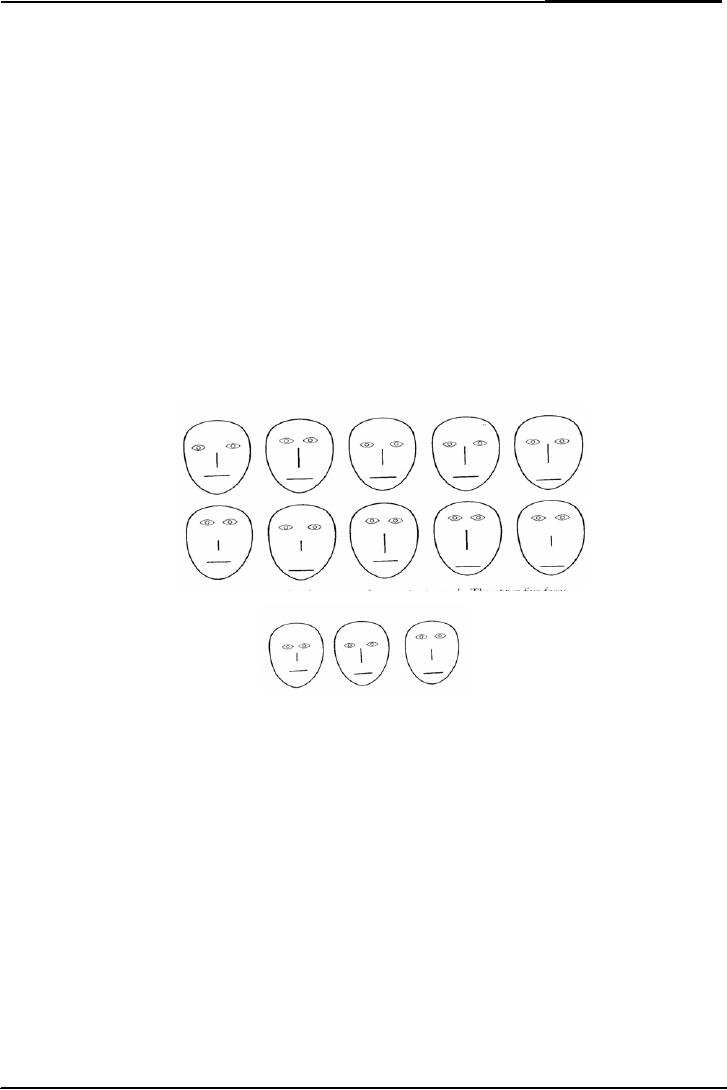 |
Memory:Prototype, Rosch and Colleagues, Experiments of Stephen Read |
| << Memory:Benefits of Categorization, Levels of Categories |
| Memory:Schema Theory, A European Solution, Generalization hierarchies >> |

Cognitive
Psychology PSY 504
VU
Lesson
35
Memory
Representation of
knowledge (continued)
Levels
of Categories:
i)
Superordinate Category: "It is a
large category at the top of
the hierarchy." e.g.
furniture,
tools,
vehicles etc.
ii)
Basic Level Category: "It
is an intermediate category in the
middle of the hierarchy."
e.g.
table,
chair, bed, sofa
etc.
iii)
Subordinate Category: "It is a
small category at the bottom
of the hierarchy." e.g.
lamp,
screw-driver,
truck etc.
Prototype
Experiment
An
experiment was conducted by
Rosch & Lackoff in 1970's on
prototypes. They collected a
lot of
evidence
for prototypes at the basic
level or the subordinate
level but not at
superordinate level.
Shown
picture of a living room
chair were:
A
piece of furniture (superordinate
level)
A
chair (basic level)
A
living room chair
(subordinate level)
Subjects
were divided into three
groups and were shown a
living room chair. One
group was
asked
you will be shown a piece of
furniture. And the second
group was asked you
will be shown
a
chair or not and the
third group was asked
you will be shown a living
room chair or not.
They
were
assigned different
tasks:
Group
1: If you see any furniture
press yes.
Group
2: If you see a chair press
yes.
Group
3: If you see a living room
chair press yes.
Results:
The
results showed that subjects
were fastest at the basic
level category i.e. chair.
Chair faster
than
furniture or living
room.
Subjects
identify objects at basic
level than make an inference
regarding superordinate
level
(chair
is a piece of furniture), or classify
them at subordinate level by
looking for
distinguishing
features.
People look first the
category than they decide it
is what kind of or level of
category.
Conclusion:
It
seems that subjects
identified objects at the
basic level.
What
about carpenters?
Experts
in an area may be very quick
to make subordinate
classification.
Experts
might be very quick to make
subordinate classifications in their
area of expertise.
Rosch
and Colleagues:
Roch
and Colleagues tried to
prove that the experts
might be very quick to make
subordinate
classifications
in their area of
expertise.
Rosch
and colleagues (1976) tested
Dog experts and bird
experts.
Dog
Experts and Bird Experts
were taken as
subjects.
103

Cognitive
Psychology PSY 504
VU
Subjects
were shown the color
pictures of dogs and
sparrows.
They
gave these instructions to
the Subjects;
i)
You will be shown an animal, if
you see an animal press
the button.
ii)
You will be shown either a
dog or an animal, if you see
a dog press the
button.
iii)
You will be shown a beagle
and a sparrow.
Replicated
earlier results when dog
experts identified birds and
bird experts identified
dogs. But in
their
area of expertise, experts
were as fast at the
subordinate level as at basic
level.
Results:
Dog
experts were fastest at the
bird condition rather then
in the sparrow condition and
slow at the
animal
level. Bird experts were
fastest at the animal
condition rather then in the
beagle condition.
Experts
were as fast at the
subordinate level as at the
subordinate level.
The
distinction between one
level and the other
level is a matter of experience
rather than the
imitation
of mind.
Experiments
of Stephen Read:
Stephen
conducted an experiment by using
these faces.
At
the top row the
faces were named category
one and the second
row was named the
category
2.
The last row was
called novel faces. After
showing the first row
and second row subjects
were
shown
a novel face and were
asked if this face belonged
to category one or category
two.
Categorization
rules
They
developed some rules prior
to the experiment. These
rules were;
1.
Nearest neighbor
rule
Matches
an item to the test item is
called nearest neighbor
rule. Subjects compare the
novel face
with
both categories and included
this face to the above
given categories.
2.
Average distance
rule
Matches
test item on the basis of
average similarity is called
average distance rule. On
the
average
this face is matched with
one category or second
category.
3.
Prototype rule
Matches
prototype with test item is
called prototype rule. By
averaging all faces subjects
make a
prototype
and then match novel
face with this
prototype.
104

Cognitive
Psychology PSY 504
VU
4.
Feature frequency
rule
Selects
on Most feature matches is
called feature frequency
rule. The answers were
included in
one
category according to the
frequency.
Results:
58%
subjects said that they
averaged the
features.
Over
50% used prototype.
Over
20% use the feature
frequency rule.
Subjects
were shown 25 novel
faces.
Conclusion:
Prototype
strategy was the most
frequently used
strategy.
Feature
frequency rule was the
second best.
Average
similarity and near neighbor
rule were least frequently
used.
There
might have been other
ways of looking at the same
problem.
There
is also evidence for
exemplar and feature
frequency rule.
Different
rules are applicable in
different situations. We all
have a tendency to apply
these four
rules.
People selectively use these
rules in different
situations.
Findings
Prototype
most frequent
Feature
frequency second best
Some
people did use
exemplar
Exemplars
Exemplar
is not our tendency to match
an object with every single
item, with every single
object in
the
category. We only match it
with a typical item in the
category.
Experiments
Nosofsky
(1991) replicated his
experiment on read experiment. And he
found many students
use
exemplars
in classification. He found that
many subjects were using
exemplar not the
prototype.
JD
Smith and JP Minda (1998)
conducted experiment and
they came up with a new
idea that is
prototype
for early learning. When
children see goat first
time and he says bowh
bowh child
thinks
it is dog. So in early learning
the children compare the
goat with dog. Probably we
use
something
like prototype in our early
learning. We may need more
integration rather
argumentation.
105
Table of Contents:
- INTRODUCTION:Historical Background
- THE INFORMATION PROCESSING APPROACH
- COGNITIVE NEUROPSYCHOLOGY:Brains of Dead People, The Neuron
- COGNITIVE NEUROPSYCHOLOGY (CONTINUED):The Eye, The visual pathway
- COGNITIVE PSYCHOLOGY (CONTINUED):Hubel & Wiesel, Sensory Memory
- VISUAL SENSORY MEMORY EXPERIMENTS (CONTINUED):Psychological Time
- ATTENTION:Single-mindedness, In Shadowing Paradigm, Attention and meaning
- ATTENTION (continued):Implications, Treisman’s Model, Norman’s Model
- ATTENTION (continued):Capacity Models, Arousal, Multimode Theory
- ATTENTION:Subsidiary Task, Capacity Theory, Reaction Time & Accuracy, Implications
- RECAP OF LAST LESSONS:AUTOMATICITY, Automatic Processing
- AUTOMATICITY (continued):Experiment, Implications, Task interference
- AUTOMATICITY (continued):Predicting flight performance, Thought suppression
- PATTERN RECOGNITION:Template Matching Models, Human flexibility
- PATTERN RECOGNITION:Implications, Phonemes, Voicing, Place of articulation
- PATTERN RECOGNITION (continued):Adaptation paradigm
- PATTERN RECOGNITION (continued):Gestalt Theory of Perception
- PATTERN RECOGNITION (continued):Queen Elizabeth’s vase, Palmer (1977)
- OBJECT PERCEPTION (continued):Segmentation, Recognition of object
- ATTENTION & PATTERN RECOGNITION:Word Superiority Effect
- PATTERN RECOGNITION (CONTINUED):Neural Networks, Patterns of connections
- PATTERN RECOGNITION (CONTINUED):Effects of Sentence Context
- MEMORY:Short Term Working Memory, Atkinson & Shiffrin Model
- MEMORY:Rate of forgetting, Size of memory set
- Memory:Activation in a network, Magic number 7, Chunking
- Memory:Chunking, Individual differences in chunking
- MEMORY:THE NATURE OF FORGETTING, Release from PI, Central Executive
- Memory:Atkinson & Shiffrin Model, Long Term Memory, Different kinds of LTM
- Memory:Spread of Activation, Associative Priming, Implications, More Priming
- Memory:Interference, The Critical Assumption, Limited capacity
- Memory:Interference, Historical Memories, Recall versus Recognition
- Memory:Are forgotten memories lost forever?
- Memory:Recognition of lost memories, Representation of knowledge
- Memory:Benefits of Categorization, Levels of Categories
- Memory:Prototype, Rosch and Colleagues, Experiments of Stephen Read
- Memory:Schema Theory, A European Solution, Generalization hierarchies
- Memory:Superset Schemas, Part hierarchy, Slots Have More Schemas
- MEMORY:Representation of knowledge (continued), Memory for stories
- Memory:Representation of knowledge, PQ4R Method, Elaboration
- Memory:Study Methods, Analyze Story Structure, Use Multiple Modalities
- Memory:Mental Imagery, More evidence, Kosslyn yet again, Image Comparison
- Mental Imagery:Eidetic Imagery, Eidetic Psychotherapy, Hot and cold imagery
- Language and thought:Productivity & Regularity, Linguistic Intuition
- Cognitive development:Assimilation, Accommodation, Stage Theory
- Cognitive Development:Gender Identity, Learning Mathematics, Sensory Memory